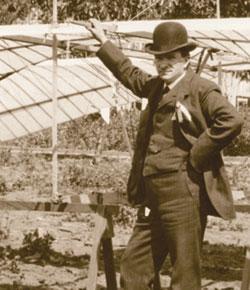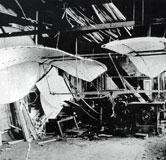John J. Montgomery:
Aeronautics Pioneer Gives Wings to Engineering at Santa Clara
Even before the School of Engineering was founded in 1912, Santa Clara College had a distinguished history of engineering innovation. John J. Montgomery, alumnus and professor of physics, was the first to pilot a manned, controlled flight of a heavier-than-air machine—20 years before the historic flights of the Wright brothers!
In 1883, Montgomery flew the glider he invented 600 feet and entered the annals of aeronautics history. Since he was in California, far from the publicized aviation trials taking place on the East Coast, and lacked the means to patent his invention, Montgomery's historic accomplishment was not immediately recognized. Still, the flight did not go unnoticed. According to Alexander Graham Bell, “All subsequent attempts in aviation must begin with the Montgomery machine.”
Following his landmark achievement in 1883, Montgomery spent the next 10 years studying the principles of flight and the relationship between the wing surface and the air. He published several papers during this time and worked on a series of model gliders before building the Santa Clara, which performed horizontal figure-eights, well-controlled turns, and spirals, soaring nearly 4,000 feet above the Santa Clara Valley for 15 to 20 minutes as witnessed by hundreds of onlookers, including members of the press.
In 1911, Montgomery built the Evergreen, using a design that was created to tolerate turbulence and wind gusts. A number of innovative elements were incorporated into the design, including single-wing, aft-tail layout and wheel-yoke control, a major step in aircraft control. It was in the testing of the controls on this craft that Montgomery met his untimely death from a head injury.
The School of Engineering owes a debt of gratitude to John J. Montgomery for ushering in a century of engineering excellence at Santa Clara.


